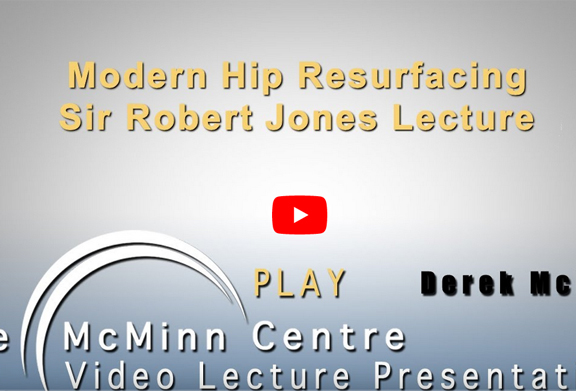|
Modern Hip Resurfacing Derek McMinn, Sir Robert Jones Lecture, New York 2008

Professor Derek McMinn presents the Sir Robert Jones Lecture in New York, 2008. Mr McMinn talks about Birmingham, the history of hip resurfacing and survivorship rates. The reasons behind implant failure are explored, comparing Birmingham Hip Resurfacing (BHR) patient outcomes with Total Hip Replacement (THR) patient results.
The Sir Robert Jones Lecture dates back to 1930 and is the oldest continuous orthopaedic lecture series in North America. Introduced by Dr Joseph D. Zuckerman MD, the lecture represents a who's who of orthopaedic surgeons throughout the world. Sir Robert Jones is considered to be one of the fathers of modern orthopaedic surgery. In this talk, Derek McMinn MD FRCS discusses Modern Hip Resurfacing.
Mr McMinn begins with a brief history of the city of Birmingham focussing on the network of canals that run through it, the origin of the 'black country', the industry and produce and the post-war development. The relationship between Birmingham and Oswestry is also discussed, with Oswestry being the home of The Robert Jones and Agnes Hunt Orthopaedic Hospital (RJAH).
In 1991, the first of the modern generation of metal-metal resurfacings were being developed by Mr McMinn. Unbeknownst to him at the time, Professor Heinz Wagner was also working on a similar implant and they were both being used and tested. The first McMinn hip resurfacing was a smooth press fit with no porous coating, no hydroxyapatite (HA) and no cement. However, patients reported pain which was caused by micromotion and the subsequent loosening of the implant was a big problem.
The survivorship curve from this first series showed an unacceptable outcome. In response to this, the cup was modified to allow it to be cemented. The femoral component was not modified but was also cemented. This combated the implant loosening but led to cement debris and osteolysis. After 3 years, a hybrid implant was developed using a hydroxyapatite cup and a cemented femoral component. These produced very good results.
In 1996 however, things started to go wrong when the manufacturer began double heat-treating the metal implants. This process seriously depletes carbides in the metal and removes the wear resistance. The reasons for implant failure were explored, looking at inclination angles and cup introducers, but the double heat treatment was the culprit. Mr McMinn has tirelessly warned against using double heat treated metal implants most notably in his 2005 Northern Lights Debate Lecture.
Hip Resurfacing is an option for a select group of young patients who meet a selection criteria. The advantages are that it offers bone conservation and long term bone preservation, reduced dislocation rate and the increased options for a revision if needed. The main plus point is that it allows for continuation of an active lifestyle.
Relative contraindications include patients of old age, women of child bearing age and sufferers of femoral head avascular necrosis (AVN). A disadvantage is the increased chance of femoral neck fracture and femoral head collapse, which do not occur in total hip replacements (THR). Other perceived disadvantages include acetabular bone loss, longer operating times and metal allergies.
The survivorship rate at ten years for the Birmingham Hip Resurfacing (BHR) for all diagnoses and age groups is 96.1 per cent. This is calculated from a total of 2600 procedures and of those, there were 43 failures. The causes of failure were deep infection (11), femoral head collapse (19), femoral neck fracture (10), dislocation (1), unexplained pain (1, revised elsewhere) and nickel hypersensitivity (1). Revision of either component was used as the end point.
The real test of any conservative arthroplasty device is its outcome in young, active patients. The ten year survivorship rate for BHR patients under 55 years old with osteoarthritis (OA) is 99.5 per cent.
Investigations into hip resurfacing in women of child bearing age showed that there is no significant difference in the exposure of chromium in the babies whose mother has a metal-metal hip compared to those whose mother has no metal device.
The following implants have a higher failure rate than the BHR, according to the Australian Register: Conserve Plus; Cormet 2000 uses the same casting as McMinn 96 (double heat treated); Durom retrieval shows a lack of bone ingrown to the acetabular component; and ASR significant wear due to removing additional six degrees from acetabular articular surface. The ASR implant has been recalled.
Poor case selection and poor surgery can be a big factor in hip resurfacing failure. Small incisions and the use of 'tyre levers' to stretch the incision can cause trauma to the soft tissue, damage muscles, lead to heterotopic ossification and disturb the neuro-musculo-skeletal-implant system.
Watch the 2013 BHR & Other Options 15 Year Results of the First 1000 BHRs lecture by Derek McMinn here.
|